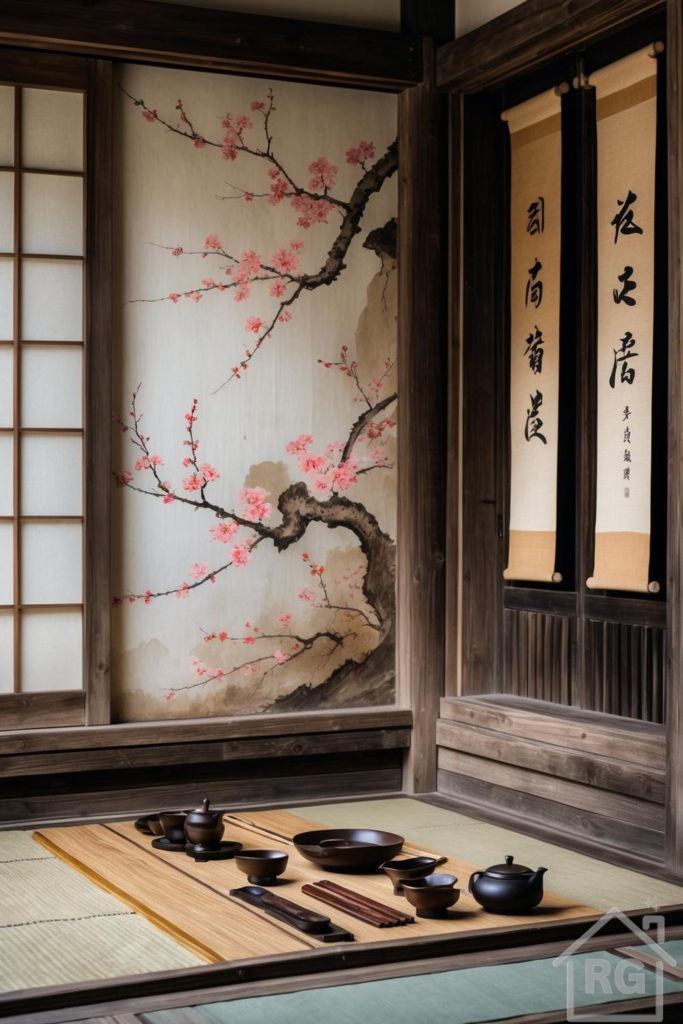
Finding Peace in Design: The Essence of a Japanese Tea Room
In our fast-paced world, carving out spaces for tranquility and mindfulness is more important than ever. The traditional Japanese tea room, or Chashitsu, offers profound inspiration for creating such havens. It’s a space dedicated to simplicity, natural beauty, and the quiet appreciation of the moment, often embodied in the tea ceremony (Chanoyu). The image above captures this essence beautifully, showcasing key elements that contribute to its serene atmosphere. Let’s explore how to bring the principles of Japanese design, particularly those seen in a tea space, into your own home.
Core Elements of Japanese Interior Design
Japanese design philosophy often revolves around principles like Wabi-Sabi (finding beauty in imperfection and transience), Shibumi (simple, subtle, and unobtrusive beauty), and Ma (the importance of negative space). These concepts translate into distinct design choices:
- Natural Materials: Wood, bamboo, rice paper, stone, and earth are fundamental. The room pictured heavily features natural wood in its structural elements, flooring accents, and tea utensils, alongside woven tatami mats and paper for the shoji screen and wall art.
- Connection to Nature: Even indoors, there’s a strong link to the natural world. This can be through large windows, the use of natural materials, or incorporating nature motifs, like the delicate cherry blossom painting seen here.
- Simplicity and Minimalism: Clutter is avoided. Spaces are kept open and functional, focusing on essential items and appreciating the beauty of emptiness (Ma).
- Subdued Color Palette: Colors are typically drawn from nature – browns, greens, greys, and creams dominate, creating a calming and earthy feel. Accents, like the soft pink of the blossoms, are used sparingly but effectively.
- Light and Shadow: The interplay of light, often filtered through shoji screens, creates a soft, diffused ambiance and highlights textures.
Deconstructing the Image: Key Features for Inspiration
Let’s break down the elements in the featured Japanese room:
- Tatami Mats: These traditional rice straw mats provide a distinct texture, scent, and soft underfoot feel. Their modular nature dictates room proportions in traditional Japanese architecture. Notice the specific way they are laid out and bordered.
- Shoji Screens: The sliding screen door with its wooden lattice and translucent rice paper (washi) is iconic. It allows diffused natural light to enter while maintaining privacy, contributing significantly to the room’s soft glow.
- Wood Framing and Structure: The exposed wooden beams, posts, and window frames showcase the beauty of natural wood grain. The joinery itself is often a point of aesthetic appreciation. The dark, aged wood provides a grounding contrast to the lighter walls and mats.
- Tokonoma (Alcove) Area: While not fully visible, the area with the painted wall and hanging scrolls suggests a Tokonoma, a recessed alcove for displaying art – typically a scroll (kakemono) and perhaps a flower arrangement (ikebana). The cherry blossom painting serves as the focal point here, bringing seasonal beauty indoors.
- Calligraphy Scrolls (Kakemono): The hanging scrolls feature Japanese calligraphy, adding an element of art, culture, and often philosophical meaning to the space.
- Tea Ceremony Set (Chadōgu): The carefully arranged tea bowls (chawan), tea caddy (natsume), kettle (kama – though not heated here), tea scoop (chashaku), and whisk (chasen – not visible but implied) on a simple wooden tray indicate the room’s purpose. The dark ceramic contrasts beautifully with the light wood tray and tatami.
- Color Palette & Textures: The room harmoniously blends textures – smooth paper, rougher woven tatami, varied wood grains, and sleek ceramic. The color palette is predominantly neutral (beiges, browns, creams, blacks) with the soft pink of the blossoms providing a gentle, natural accent.
Tips for Creating Your Own Japanese-Inspired Space
You don’t need a dedicated room to capture this feeling. Apply these principles to a corner, a reading nook, or even your entire living area:
- Declutter Ruthlessly: Embrace minimalism. Keep only items that are essential, functional, or bring you joy. Utilize concealed storage.
- Incorporate Natural Materials: Use wood furniture, bamboo blinds, jute or seagrass rugs (as a nod to tatami), stone coasters, or ceramic accessories.
- Choose an Earthy Palette: Stick to neutrals like beige, cream, brown, grey, and off-white as your base. Add subtle accents of green, blue, or soft pink inspired by nature.
- Manage Light: Opt for soft, diffused lighting. Use sheer curtains, paper lampshades (like Akari lamps), or blinds that filter sunlight gently. Avoid harsh overhead lighting.
- Add Natural Elements: Bring in plants (like bonsai or bamboo), display simple branches, or use artwork depicting nature scenes. A single, beautifully rendered image, like the cherry blossom painting, can have more impact than multiple busy pieces.
- Focus on Texture: Combine different natural textures – smooth wood, woven fabrics, rough pottery, smooth ceramics – to add depth and interest without relying on color or pattern.
- Create a Focal Point: Designate an area, like a simple shelf or console table, to act as a mini-Tokonoma where you can display a single piece of art, a vase with a simple arrangement, or a meaningful object. Rotate items seasonally.
- Consider Low Seating: Floor cushions (zabuton) or low-profile furniture can enhance the grounded, centered feeling characteristic of Japanese interiors.
Cultivating Mindfulness Through Design
Ultimately, designing a Japanese-inspired space is about more than just aesthetics; it’s about creating an environment that encourages calm, reflection, and an appreciation for simple beauty. By carefully selecting materials, managing light and space, and focusing on natural elements, you can craft a personal sanctuary that offers respite from the everyday hustle. Whether it’s a dedicated tea corner or simply adopting a more mindful approach to your existing decor, the principles embodied in the traditional Japanese tea room provide timeless guidance for creating spaces that soothe the soul.
